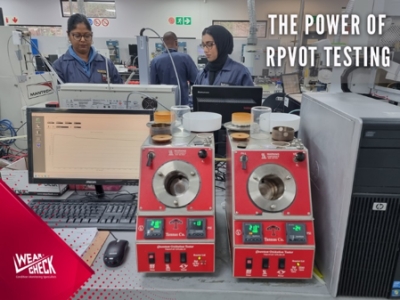There are multiple degradation pathways that turbine oil faces under operational stress, but the dominant failure mode in an operating system is oxidation, one of the primary causes of lubricant degradation.
Simply put, oxidation occurs when oxygen reacts with the hydrocarbon molecules in the base oil of a lubricant. The oxidation process is significantly accelerated by heat, with a 10°C increase in oil temperature effectively doubling the oxidation rate. Contaminants such as water, and metallic wear particles containing copper or iron, act as catalysts, further speeding up oxidation.
As oil oxidises, it forms acids and insoluble oxidation products, which can lead to formation of sludge or varnish. These degradation products can coat bearing and oil-cooler surfaces, preventing adequate cooling of the bearings. Areas with tight tolerances such as hydraulic control valves can also become coated, causing operational issues. What’s more, as the oil oxidises, its foam control, demulsibility and air-release characteristics will likely deteriorate.
In a nutshell, poor oxidation resistance shortens the oil’s service life.
All turbine oils contain antioxidants, which serve as the base oil’s first line of defence against oxidation. However, like all additives, antioxidants are sacrificial in nature and must be monitored through advanced oil analysis to determine the oil’s remaining life. This allows for proactive planning of oil replenishment and maintenance activities.
One such advanced oil analysis technique is the Rotating Pressure Vessel Oxidation Test (RPVOT).
The RPVOT is an essential tool in the lubricant industry for evaluating a lubricant’s oxidation resistance, particularly for turbine oils, hydraulic fluids, and other industrial lubricants. This test is crucial for ensuring that lubricants can withstand the oxidative stress encountered during operation, thereby extending their service life and protecting machinery from premature wear.
Let’s take a closer look at how WearCheck performs RPVOT analysis using ASTM D2272 – Method B.
The test begins by placing a predetermined amount of the lubricant sample, along with distilled water and a copper catalyst coil, into a glass container. This container is then sealed and placed inside a rotating pressure vessel, which is filled with oxygen to a specified pressure and heated to a standardised temperature (typically around 150°C).
Initially, the antioxidant additives in the oil resist oxidation. However, once these additives are depleted, the oil starts to oxidise, leading to a pressure drop within the vessel. The test continues until the pressure drops by a predetermined amount, with the time taken for this drop indicating the oxidation stability of the sample.
Depending on the condition of the sample, the test duration can range from 200 minutes to over 3,000 minutes. The result is reported as the time, in minutes, required for the pressure drop to occur. A longer RPVOT time suggests better oxidation stability, indicating that the lubricant is more robust and capable of performing well under oxidative stress.
For industries where equipment reliability is paramount, performing regular RPVOT analysis is invaluable, as it provides an early warning of potential lubricant degradation issues that can escalate to unplanned downtime. The cost of changing the oil in an industrial turbine is substantial, so maximising lubricant life is key. However, the greatest financial benefit of advanced oil analysis techniques like RPVOT is improved machine reliability and overall operational integrity.

